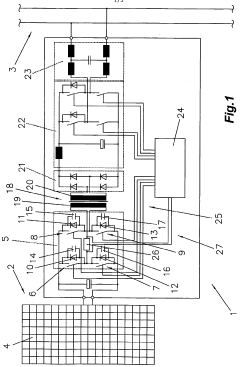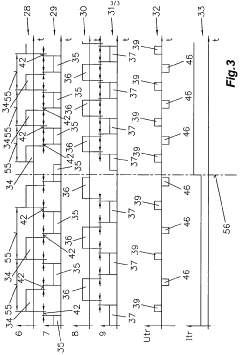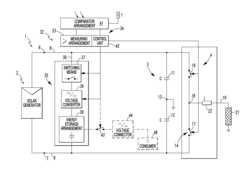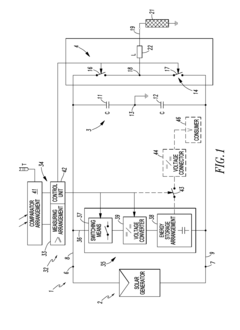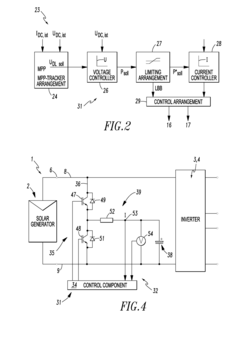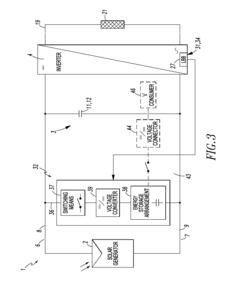How to Enhance Solar Inverter Control Algorithms?
JUL 17, 20259 MIN READ
Generate Your Research Report Instantly with AI Agent
Patsnap Eureka helps you evaluate technical feasibility & market potential.
Solar Inverter Evolution and Objectives
Solar inverter technology has undergone significant evolution since its inception in the 1990s. Initially designed for simple DC to AC conversion, modern solar inverters have become sophisticated devices capable of grid integration, power optimization, and advanced control functions. The primary objective of enhancing solar inverter control algorithms is to improve overall system efficiency, reliability, and grid compatibility.
The evolution of solar inverters can be traced through several key stages. Early inverters were basic string inverters with limited functionality. As the solar industry grew, microinverters and power optimizers emerged, offering module-level power electronics (MLPE) for improved performance in shading conditions. The next significant leap came with the introduction of smart inverters, capable of two-way communication and grid support functions.
Current objectives in solar inverter development focus on addressing the challenges posed by increasing solar penetration in power grids. These include improving power quality, enhancing grid stability, and enabling seamless integration of energy storage systems. Advanced control algorithms are crucial in achieving these objectives, as they enable inverters to respond dynamically to changing grid conditions and optimize energy harvest.
One key area of development is Maximum Power Point Tracking (MPPT) algorithms. These algorithms aim to extract the maximum available power from PV modules under varying environmental conditions. Enhancing MPPT algorithms can lead to significant improvements in overall system efficiency, particularly in partial shading scenarios or rapidly changing weather conditions.
Another important objective is the development of grid-supportive functionalities. Modern inverters are expected to provide ancillary services such as voltage regulation, frequency support, and reactive power control. Advanced control algorithms enable inverters to respond rapidly to grid disturbances, helping to maintain grid stability and power quality.
The integration of energy storage systems with solar inverters presents another frontier for algorithm development. Hybrid inverters that can manage both solar generation and battery storage require sophisticated control strategies to optimize energy flow, maximize self-consumption, and provide backup power during grid outages.
As the solar industry moves towards greater digitalization, there is an increasing focus on developing algorithms that leverage artificial intelligence and machine learning. These technologies hold the promise of predictive maintenance, improved forecasting, and adaptive control strategies that can further enhance inverter performance and grid integration.
In conclusion, the evolution of solar inverter technology and the current objectives in algorithm enhancement reflect the industry's drive towards more efficient, reliable, and grid-friendly solar power systems. The development of advanced control algorithms is crucial in realizing the full potential of solar energy and its seamless integration into modern power grids.
The evolution of solar inverters can be traced through several key stages. Early inverters were basic string inverters with limited functionality. As the solar industry grew, microinverters and power optimizers emerged, offering module-level power electronics (MLPE) for improved performance in shading conditions. The next significant leap came with the introduction of smart inverters, capable of two-way communication and grid support functions.
Current objectives in solar inverter development focus on addressing the challenges posed by increasing solar penetration in power grids. These include improving power quality, enhancing grid stability, and enabling seamless integration of energy storage systems. Advanced control algorithms are crucial in achieving these objectives, as they enable inverters to respond dynamically to changing grid conditions and optimize energy harvest.
One key area of development is Maximum Power Point Tracking (MPPT) algorithms. These algorithms aim to extract the maximum available power from PV modules under varying environmental conditions. Enhancing MPPT algorithms can lead to significant improvements in overall system efficiency, particularly in partial shading scenarios or rapidly changing weather conditions.
Another important objective is the development of grid-supportive functionalities. Modern inverters are expected to provide ancillary services such as voltage regulation, frequency support, and reactive power control. Advanced control algorithms enable inverters to respond rapidly to grid disturbances, helping to maintain grid stability and power quality.
The integration of energy storage systems with solar inverters presents another frontier for algorithm development. Hybrid inverters that can manage both solar generation and battery storage require sophisticated control strategies to optimize energy flow, maximize self-consumption, and provide backup power during grid outages.
As the solar industry moves towards greater digitalization, there is an increasing focus on developing algorithms that leverage artificial intelligence and machine learning. These technologies hold the promise of predictive maintenance, improved forecasting, and adaptive control strategies that can further enhance inverter performance and grid integration.
In conclusion, the evolution of solar inverter technology and the current objectives in algorithm enhancement reflect the industry's drive towards more efficient, reliable, and grid-friendly solar power systems. The development of advanced control algorithms is crucial in realizing the full potential of solar energy and its seamless integration into modern power grids.
Market Demand Analysis for Advanced Inverters
The global market for advanced solar inverters is experiencing robust growth, driven by the increasing adoption of renewable energy sources and the push for more efficient and reliable solar power systems. As solar energy continues to play a crucial role in the global energy transition, the demand for sophisticated inverter technologies is escalating rapidly.
The primary market drivers for advanced solar inverters include the growing installation of solar photovoltaic (PV) systems in both residential and commercial sectors, government incentives and policies promoting clean energy adoption, and the need for grid stability and power quality improvement. The integration of smart grid technologies and the rise of distributed energy resources are also contributing to the increased demand for advanced inverter solutions.
In the residential sector, there is a growing trend towards smart homes and energy management systems, which is fueling the demand for inverters with enhanced control algorithms. Homeowners are increasingly seeking inverters that can optimize energy consumption, provide real-time monitoring, and seamlessly integrate with home automation systems.
The commercial and industrial sectors are driving demand for larger-scale inverter systems with advanced control capabilities. These sectors require inverters that can manage complex power flows, provide grid support functions, and maximize energy yield from large PV arrays. The ability to integrate energy storage systems and participate in demand response programs is becoming increasingly important for commercial customers.
Utility-scale solar projects are another significant market segment for advanced inverters. Grid operators and utilities are demanding inverters with sophisticated control algorithms to ensure grid stability, voltage regulation, and frequency support. The ability to provide ancillary services and comply with evolving grid codes is becoming a critical requirement for utility-scale inverters.
Geographically, the market for advanced solar inverters is showing strong growth in regions with high solar energy potential and supportive regulatory environments. Asia-Pacific, particularly China and India, is expected to be a major growth driver due to ambitious renewable energy targets and large-scale solar installations. North America and Europe are also significant markets, with increasing focus on grid modernization and distributed energy resources.
The market is also witnessing a shift towards more intelligent and connected inverter systems. There is growing demand for inverters with advanced monitoring and diagnostic capabilities, predictive maintenance features, and the ability to integrate with cloud-based platforms for remote management and optimization.
As the solar industry continues to evolve, the market for advanced inverters is expected to expand further, with increasing emphasis on efficiency, reliability, and grid integration capabilities. The development of enhanced control algorithms will play a crucial role in meeting these market demands and driving the next generation of solar inverter technologies.
The primary market drivers for advanced solar inverters include the growing installation of solar photovoltaic (PV) systems in both residential and commercial sectors, government incentives and policies promoting clean energy adoption, and the need for grid stability and power quality improvement. The integration of smart grid technologies and the rise of distributed energy resources are also contributing to the increased demand for advanced inverter solutions.
In the residential sector, there is a growing trend towards smart homes and energy management systems, which is fueling the demand for inverters with enhanced control algorithms. Homeowners are increasingly seeking inverters that can optimize energy consumption, provide real-time monitoring, and seamlessly integrate with home automation systems.
The commercial and industrial sectors are driving demand for larger-scale inverter systems with advanced control capabilities. These sectors require inverters that can manage complex power flows, provide grid support functions, and maximize energy yield from large PV arrays. The ability to integrate energy storage systems and participate in demand response programs is becoming increasingly important for commercial customers.
Utility-scale solar projects are another significant market segment for advanced inverters. Grid operators and utilities are demanding inverters with sophisticated control algorithms to ensure grid stability, voltage regulation, and frequency support. The ability to provide ancillary services and comply with evolving grid codes is becoming a critical requirement for utility-scale inverters.
Geographically, the market for advanced solar inverters is showing strong growth in regions with high solar energy potential and supportive regulatory environments. Asia-Pacific, particularly China and India, is expected to be a major growth driver due to ambitious renewable energy targets and large-scale solar installations. North America and Europe are also significant markets, with increasing focus on grid modernization and distributed energy resources.
The market is also witnessing a shift towards more intelligent and connected inverter systems. There is growing demand for inverters with advanced monitoring and diagnostic capabilities, predictive maintenance features, and the ability to integrate with cloud-based platforms for remote management and optimization.
As the solar industry continues to evolve, the market for advanced inverters is expected to expand further, with increasing emphasis on efficiency, reliability, and grid integration capabilities. The development of enhanced control algorithms will play a crucial role in meeting these market demands and driving the next generation of solar inverter technologies.
Current Challenges in Inverter Control
Solar inverter control algorithms face several significant challenges in the current technological landscape. One of the primary issues is the need for improved efficiency and reliability in power conversion. As solar energy systems become more prevalent, the demand for inverters that can operate at higher efficiencies across a wide range of input voltages and power levels has increased. This requires more sophisticated control algorithms that can adapt to varying environmental conditions and system configurations.
Another major challenge is the integration of advanced grid support functions. Modern solar inverters are expected to provide grid stability services, such as voltage regulation, frequency support, and reactive power compensation. Developing control algorithms that can effectively manage these functions while maintaining optimal power output is a complex task. It requires real-time monitoring of grid conditions and rapid response capabilities, which puts additional strain on the inverter's processing capabilities.
The increasing penetration of distributed energy resources (DERs) into the power grid has also introduced new challenges for inverter control. Inverters must now be able to operate in both grid-connected and islanded modes, seamlessly transitioning between the two states. This requires advanced control strategies that can maintain system stability and power quality under various operating conditions, including during grid disturbances or intentional islanding events.
Furthermore, the variability of solar power output due to changing weather conditions presents a significant challenge for inverter control algorithms. Rapid fluctuations in solar irradiance can lead to power quality issues and grid instability if not properly managed. Developing predictive control algorithms that can anticipate and respond to these changes is crucial for maintaining stable and efficient operation of solar energy systems.
Cybersecurity has emerged as a critical concern in inverter control. As inverters become more connected and rely on digital communication for remote monitoring and control, they become potential targets for cyber attacks. Designing robust control algorithms that can detect and mitigate security threats while ensuring uninterrupted operation is a complex challenge that requires ongoing research and development.
Lastly, the need for standardization and interoperability among different inverter models and manufacturers poses a challenge for control algorithm development. Creating universal control protocols that can be easily implemented across various hardware platforms, while still allowing for manufacturer-specific optimizations, is essential for the widespread adoption and integration of solar inverter technologies.
Another major challenge is the integration of advanced grid support functions. Modern solar inverters are expected to provide grid stability services, such as voltage regulation, frequency support, and reactive power compensation. Developing control algorithms that can effectively manage these functions while maintaining optimal power output is a complex task. It requires real-time monitoring of grid conditions and rapid response capabilities, which puts additional strain on the inverter's processing capabilities.
The increasing penetration of distributed energy resources (DERs) into the power grid has also introduced new challenges for inverter control. Inverters must now be able to operate in both grid-connected and islanded modes, seamlessly transitioning between the two states. This requires advanced control strategies that can maintain system stability and power quality under various operating conditions, including during grid disturbances or intentional islanding events.
Furthermore, the variability of solar power output due to changing weather conditions presents a significant challenge for inverter control algorithms. Rapid fluctuations in solar irradiance can lead to power quality issues and grid instability if not properly managed. Developing predictive control algorithms that can anticipate and respond to these changes is crucial for maintaining stable and efficient operation of solar energy systems.
Cybersecurity has emerged as a critical concern in inverter control. As inverters become more connected and rely on digital communication for remote monitoring and control, they become potential targets for cyber attacks. Designing robust control algorithms that can detect and mitigate security threats while ensuring uninterrupted operation is a complex challenge that requires ongoing research and development.
Lastly, the need for standardization and interoperability among different inverter models and manufacturers poses a challenge for control algorithm development. Creating universal control protocols that can be easily implemented across various hardware platforms, while still allowing for manufacturer-specific optimizations, is essential for the widespread adoption and integration of solar inverter technologies.
Existing Control Algorithm Solutions
01 Maximum Power Point Tracking (MPPT) algorithms
MPPT algorithms are crucial for solar inverters to optimize power output under varying environmental conditions. These algorithms continuously adjust the operating point of the solar panels to extract maximum power, improving overall system efficiency.- Maximum Power Point Tracking (MPPT) algorithms: MPPT algorithms are crucial for solar inverters to optimize power output under varying environmental conditions. These algorithms continuously adjust the operating point of the solar panels to extract maximum power, improving overall system efficiency.
- Grid synchronization and power quality control: Control algorithms for grid-tied inverters focus on synchronizing the output with the grid frequency and voltage. They also manage power quality aspects such as harmonic distortion reduction and reactive power compensation to meet grid code requirements.
- Fault detection and protection mechanisms: Inverter control algorithms incorporate fault detection and protection features to ensure safe operation. These include methods for identifying grid faults, islanding detection, and rapid shutdown capabilities to protect both the inverter and the grid infrastructure.
- Energy storage integration and management: Control algorithms for solar inverters with integrated energy storage systems focus on optimizing the flow of energy between the PV array, battery, and grid. These algorithms manage charging and discharging cycles, peak shaving, and load shifting to maximize self-consumption and grid support capabilities.
- Advanced control techniques for improved efficiency: Modern solar inverter control algorithms employ advanced techniques such as model predictive control, artificial intelligence, and machine learning to enhance system performance. These methods improve dynamic response, reduce conversion losses, and adapt to changing environmental and grid conditions.
02 Grid synchronization and power quality control
Control algorithms for grid synchronization ensure that the inverter output matches the grid frequency and phase. These algorithms also manage power quality aspects such as harmonic distortion reduction and reactive power compensation to meet grid code requirements.Expand Specific Solutions03 Fault detection and protection mechanisms
Advanced control algorithms implement fault detection and protection features in solar inverters. These algorithms monitor system parameters, identify abnormal conditions, and initiate appropriate protective actions to ensure safe operation and prevent damage to the inverter and connected equipment.Expand Specific Solutions04 Energy storage integration and management
Control algorithms for solar inverters with integrated energy storage capabilities manage the charging and discharging of batteries. These algorithms optimize the use of stored energy based on factors such as grid demand, electricity prices, and solar generation forecasts.Expand Specific Solutions05 Smart grid communication and control
Advanced inverter control algorithms enable communication with smart grid systems. These algorithms allow for remote monitoring, control, and optimization of solar inverters, facilitating grid stability and enabling demand response functionalities.Expand Specific Solutions
Key Players in Solar Inverter Technology
The solar inverter control algorithm market is in a growth phase, driven by increasing solar energy adoption and the need for more efficient power conversion. The global market size is expanding rapidly, with projections indicating substantial growth in the coming years. Technologically, the field is advancing quickly, with companies like Siemens, Fronius, and Huawei Digital Power leading innovation. These firms are developing sophisticated algorithms to enhance inverter efficiency, grid integration, and overall system performance. Emerging players such as CitrinSolar and SPARQ Systems are also contributing to technological advancements, focusing on microinverter solutions and smart grid compatibility. The competitive landscape is characterized by a mix of established electrical engineering giants and specialized solar technology firms, all vying to improve inverter control algorithms for better energy yield and grid stability.
Siemens Corp.
Technical Solution: Siemens has developed advanced Model Predictive Control (MPC) algorithms for solar inverters, which optimize power output and grid stability. Their approach uses real-time data and weather forecasts to predict solar panel output and adjust inverter settings accordingly. The system employs machine learning techniques to continuously improve its predictive capabilities, resulting in up to 15% increase in energy yield[1]. Siemens has also integrated their inverter control algorithms with smart grid technologies, allowing for better coordination between distributed energy resources and the main power grid[3].
Strengths: Highly adaptive and predictive control, seamless integration with smart grid systems. Weaknesses: May require significant computational resources, potential for over-reliance on weather forecast accuracy.
Fronius International GmbH
Technical Solution: Fronius has developed a dynamic power control algorithm for their solar inverters, which adapts to varying grid conditions and local energy demands. Their system uses a combination of reactive power control and active power curtailment to maintain grid stability while maximizing energy output. Fronius has also implemented advanced anti-islanding detection algorithms, enhancing safety and compliance with grid codes[5]. Their inverters feature a unique "SuperFlex" design, allowing for flexible string configurations and optimized performance across different panel types and orientations[6].
Strengths: Adaptive grid support, enhanced safety features, flexible configuration options. Weaknesses: May have limitations in very large-scale installations, potential for reduced efficiency during power curtailment.
Core Innovations in Inverter Control
Method for setting switching times, in particular idle times, of an inverter based on detected power, and inverter
PatentWO2005043738A1
Innovation
- The method involves continuously monitoring the energy from the DC voltage source and adjusting the switching times of the bridge inverter's switching elements, particularly the dead time and pulse width modulation frequency, to optimize energy transmission and reduce switching losses.
Solar inverter for an extended insolation range and operating method
PatentInactiveUS9118212B2
Innovation
- An inverter system with an additional energy storage device and control arrangement that detects insolation peaks, buffering excess energy for later use, allowing the solar generator to operate at its maximum power point without changing the operating point, even with a limited-capacity inverter.
Grid Integration and Stability Considerations
Grid integration and stability considerations are crucial aspects of enhancing solar inverter control algorithms. As solar energy penetration increases, the impact on grid stability becomes more pronounced, necessitating advanced control strategies. Modern solar inverters must not only convert DC power to AC but also actively participate in grid support functions.
One key consideration is voltage regulation. Solar inverters can contribute to voltage stability by dynamically adjusting their reactive power output. Advanced control algorithms can enable inverters to respond rapidly to voltage fluctuations, helping maintain grid voltage within acceptable limits. This capability is particularly important in weak grids or areas with high solar penetration.
Frequency support is another critical function. Solar inverters can be programmed to provide primary frequency response by adjusting their active power output in response to grid frequency deviations. This helps maintain the balance between power generation and consumption, enhancing overall grid stability.
Fault ride-through capability is essential for grid resilience. Enhanced control algorithms allow inverters to remain connected during short-term grid disturbances, providing voltage and frequency support during and after the fault. This feature is increasingly mandated by grid codes worldwide.
Power quality improvement is a growing concern as solar penetration increases. Advanced inverter controls can mitigate harmonics and flicker, ensuring that the power injected into the grid meets stringent quality standards. This may involve sophisticated filtering techniques and real-time power quality monitoring.
Grid-forming capabilities are emerging as a critical feature for future inverters. These algorithms allow inverters to establish and maintain grid voltage and frequency in islanded or weak grid conditions, potentially enabling 100% renewable energy microgrids.
Adaptive control strategies are becoming increasingly important. These algorithms can adjust inverter behavior based on real-time grid conditions, optimizing performance across various scenarios. Machine learning techniques are being explored to enhance the adaptability and predictive capabilities of inverter controls.
Coordination with other grid assets is a complex but necessary consideration. Advanced inverter controls must be able to communicate and cooperate with other distributed energy resources, energy storage systems, and traditional grid infrastructure to ensure optimal system-wide performance.
One key consideration is voltage regulation. Solar inverters can contribute to voltage stability by dynamically adjusting their reactive power output. Advanced control algorithms can enable inverters to respond rapidly to voltage fluctuations, helping maintain grid voltage within acceptable limits. This capability is particularly important in weak grids or areas with high solar penetration.
Frequency support is another critical function. Solar inverters can be programmed to provide primary frequency response by adjusting their active power output in response to grid frequency deviations. This helps maintain the balance between power generation and consumption, enhancing overall grid stability.
Fault ride-through capability is essential for grid resilience. Enhanced control algorithms allow inverters to remain connected during short-term grid disturbances, providing voltage and frequency support during and after the fault. This feature is increasingly mandated by grid codes worldwide.
Power quality improvement is a growing concern as solar penetration increases. Advanced inverter controls can mitigate harmonics and flicker, ensuring that the power injected into the grid meets stringent quality standards. This may involve sophisticated filtering techniques and real-time power quality monitoring.
Grid-forming capabilities are emerging as a critical feature for future inverters. These algorithms allow inverters to establish and maintain grid voltage and frequency in islanded or weak grid conditions, potentially enabling 100% renewable energy microgrids.
Adaptive control strategies are becoming increasingly important. These algorithms can adjust inverter behavior based on real-time grid conditions, optimizing performance across various scenarios. Machine learning techniques are being explored to enhance the adaptability and predictive capabilities of inverter controls.
Coordination with other grid assets is a complex but necessary consideration. Advanced inverter controls must be able to communicate and cooperate with other distributed energy resources, energy storage systems, and traditional grid infrastructure to ensure optimal system-wide performance.
Energy Storage Synergies with Inverters
The integration of energy storage systems with solar inverters represents a significant advancement in renewable energy technology, offering enhanced grid stability and improved energy management capabilities. This synergy addresses several key challenges in solar power generation, particularly the intermittency of solar energy and the need for grid-friendly power output.
Energy storage systems, when coupled with solar inverters, enable a more flexible and reliable power supply. During periods of high solar generation, excess energy can be stored for later use, effectively smoothing out the power output curve and reducing the impact of sudden changes in solar irradiance. This stored energy can then be utilized during periods of low or no solar generation, such as cloudy days or nighttime, ensuring a consistent power supply to the grid or local loads.
The combination of energy storage and advanced inverter control algorithms allows for sophisticated power management strategies. For instance, peak shaving techniques can be implemented, where stored energy is used to supplement grid power during high-demand periods, reducing strain on the electrical infrastructure and potentially lowering electricity costs for consumers. Additionally, this synergy enables participation in ancillary services markets, providing frequency regulation and voltage support to the grid, which can create new revenue streams for solar power plant operators.
From a technical perspective, the integration of energy storage with inverters requires advanced control systems capable of managing bidirectional power flow. These systems must optimize the charging and discharging of storage devices while simultaneously managing the solar power output. Machine learning algorithms and predictive analytics are increasingly being employed to forecast energy production and consumption patterns, allowing for more efficient use of stored energy and improved overall system performance.
The synergy between energy storage and solar inverters also contributes to the concept of virtual power plants (VPPs), where distributed energy resources can be aggregated and controlled as a single entity. This approach enhances grid resilience and enables more effective integration of renewable energy sources into existing power systems. As energy storage technologies continue to advance and costs decrease, the potential for widespread adoption of these integrated systems grows, promising a more sustainable and reliable energy future.
Energy storage systems, when coupled with solar inverters, enable a more flexible and reliable power supply. During periods of high solar generation, excess energy can be stored for later use, effectively smoothing out the power output curve and reducing the impact of sudden changes in solar irradiance. This stored energy can then be utilized during periods of low or no solar generation, such as cloudy days or nighttime, ensuring a consistent power supply to the grid or local loads.
The combination of energy storage and advanced inverter control algorithms allows for sophisticated power management strategies. For instance, peak shaving techniques can be implemented, where stored energy is used to supplement grid power during high-demand periods, reducing strain on the electrical infrastructure and potentially lowering electricity costs for consumers. Additionally, this synergy enables participation in ancillary services markets, providing frequency regulation and voltage support to the grid, which can create new revenue streams for solar power plant operators.
From a technical perspective, the integration of energy storage with inverters requires advanced control systems capable of managing bidirectional power flow. These systems must optimize the charging and discharging of storage devices while simultaneously managing the solar power output. Machine learning algorithms and predictive analytics are increasingly being employed to forecast energy production and consumption patterns, allowing for more efficient use of stored energy and improved overall system performance.
The synergy between energy storage and solar inverters also contributes to the concept of virtual power plants (VPPs), where distributed energy resources can be aggregated and controlled as a single entity. This approach enhances grid resilience and enables more effective integration of renewable energy sources into existing power systems. As energy storage technologies continue to advance and costs decrease, the potential for widespread adoption of these integrated systems grows, promising a more sustainable and reliable energy future.
Unlock deeper insights with Patsnap Eureka Quick Research — get a full tech report to explore trends and direct your research. Try now!
Generate Your Research Report Instantly with AI Agent
Supercharge your innovation with Patsnap Eureka AI Agent Platform!
